The 13 Best Video Hosting Sites for 2024 (Free & Paid Options)
Andrew Folkler
Video content has become a staple in content marketing.
Whether you post videos on social media, host webinars, train through mobile learning, or teach through online courses, video can elevate the quality of your content.
If you are planning on creating a wealth of video content, one big question will probably come to mind: where do you host your videos? Choosing the right video hosting site is crucial, as it will help you store and distribute your content to your target audience.
This article will be your definitive guide to video hosting sites. You will learn about the differences between paid and free video hosting and which video-sharing platforms are best for your business.
Let’s dive right in!
Why Do You Need a Video Hosting Site?

Video hosting sites offer many benefits for business owners.
It’s important to keep in mind that a hosting site is more than just a place to upload and house your videos. It is actually a centralized hub where you can store and share your video content while tracking the performance of each video. You also are able to create evergreen links that you can share across multiple platforms.
Most video hosting platforms also offer adjustable privacy settings. For example, let’s say you are launching a product and only want to allow video access for a specific timeframe. You can adjust access by unlisting a video so that people cannot view it anymore. This can be handy for launches where you might be promoting a limited-time offer.
Another key benefit is that video hosting platforms have data tracking and analytics capabilities. Depending on the platform, you can track key metrics like total views, average watch time, common drop-off points, and even the demographics of your viewers.
If you regularly host webinars or livestreams, some video hosts allow you to do so on their platform. You can record your livestream, and it will automatically save itself on your account so that your followers can easily watch it at their convenience.
Now that you have a better understanding of the value that a video host can bring to your business, let’s explore the best platforms in the industry today.
What is the Best Video Hosting Site for Me?
There are two main categories of video hosting: free and paid platforms.
And the difference between them goes beyond just paying for one platform and not paying for the other.
Free video hosting platforms have a different business model compared to premium platforms. A free platform will have a lower barrier to entry in terms of viewers, but they will make up for their costs via advertising. On the other hand, paid platforms generate revenue through subscriptions. They may not be the best for creating viral content, but you will have greater power over who sees your video.
It all comes down to your goals with your video.
A free platform like Facebook or YouTube will have billions of users who could potentially view your content. Therefore, you must include compelling social media copywriting to attract your audience to your channel and get them to watch your video.
However, if casting a wide net is not your objective, you may just want to send a video link to your email list to a private video that only they can see. That is where paid hosting sites come in.
Here is a deeper dive into both free and paid video hosting sites.
13 Best Video Hosting Sites of 2024
Free Video Hosting Sites
1. YouTube
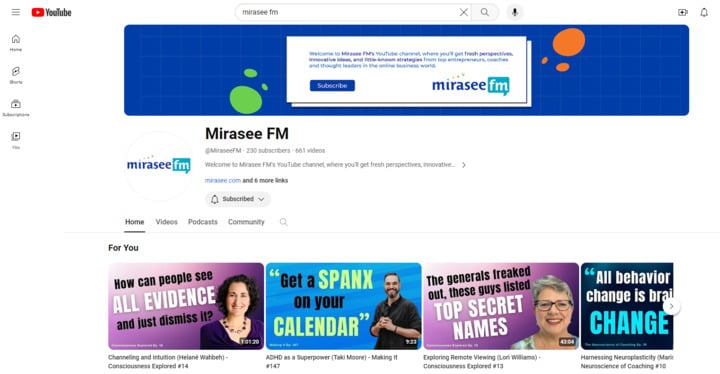
Whenever you think about uploading a video online, YouTube is one of the first places that comes to mind. With over 2.49 Billion users per month, YouTube has the potential to showcase your videos to a broad audience for free.
Since Google owns YouTube, you can also leverage SEO to increase your video’s visibility through search engines. Monetization is possible through YouTube’s Partner Program (YPP). To monetize your videos, you must first have over 1,000 subscribers and a total of 4,000 watch hours in the past 12 months.
YouTube provides unlimited cloud storage for your videos and analytics to track your engagement. You can upload videos up to 12 hours long or a maximum size of 128 Gigabytes. Videos automatically have a unique URL and can easily be embedded in your website. Most video file formats are accepted when uploading to YouTube.
Now, YouTube does have a few limitations. First, you cannot download YouTube videos without third-party software.
In addition, if your channel reaches a large enough audience, you may have difficulty with bot accounts pushing phishing scams or malware. These bots often appear in the comment section of your videos, and some even have account names posing as you. Unfortunately, these bot accounts will need to be removed manually as they can negatively impact your viewer’s experience.
Another challenge with YouTube is frequent copyright infringement. Content creators often find their videos reposted on fake accounts, which can draw viewers away from their primary channel. These fake accounts can impact your overall viewership, directly affecting monetization efforts.
Even though YouTube is a popular platform, it will require strategy and routine maintenance in order to ensure you have a healthy account and a safe place for your audience to view your videos.
2. Daily Motion

Daily Motion is another free video hosting platform to consider. What makes Daily Motion different from YouTube? In general, YouTube tends to focus more on user-generated content, while Daily Motion is typically where professionally produced video content is uploaded. This doesn’t mean you cannot post user-generated content on Daily Motion, but it casts a smaller net compared to YouTube.
Founded by a French company in 2005, Daily Motion is available in 183 languages and has over 400 million users worldwide.
Daily Motion also allows you to post an unlimited number of videos. However, the longest video you can post is up to 1 hour or 2 Gigabytes in size. Most video file formats are accepted for uploading.
Daily Motion’s popularity makes it both advantageous and disadvantageous. While there is less competition on the site, there are also fewer viewers overall. This means you will have less trouble growing your audience but achieving exponential growth is much harder. Additionally, Daily Motion is fully supported by ad revenue, meaning ads are played on all videos regardless of audience size.
3. Facebook
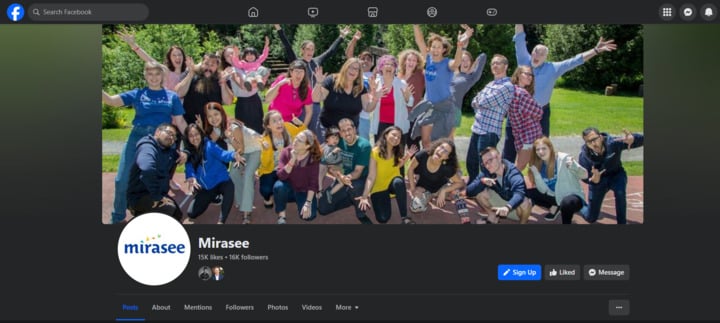
Next on our list of free video hosting platforms is the industry giant Facebook. With over 3,065 billion monthly active users, Facebook is a prime place for you to produce and share video content.
With their community and page features, you can easily share videos, host livestreams, and engage with your audience. You can upload as many videos as you want as long as they are under 2 hours long or 4 Gigabytes in size. The true power of Facebook is in your ability to build an audience you can sell to.
Facebook’s limitations are largely in its automatic ads and video quality. Ads automatically play on videos, which can be a big turnoff for viewers before they even see your content. Additionally, the quality cap on videos is lower than on other platforms.
Overall, Facebook is a powerful tool for building a community and growing your brand. However, if you try to use Facebook in a way that is not intended, you will find it lacking.
Premium Video Hosting Sites
4. WordPress Plugin: Jetpack

If you have a WordPress website, you may be looking for a convenient way to upload and share your videos, and the Jetpack plugin can do that.
At only $4.95/month, you can drag and drop videos into your page while managing everything in your WordPress media library. Jetpack also offers higher-tier packages that allow you to upload more videos and store them.
Now, you might be thinking, why can’t I just upload my videos directly to my WordPress library without Jetpack? The answer is that your website only has limited storage space, depending on your website hosting plan. If you upload too many videos, you cannot create other content on your website, like blogs and pages, or add media like photos.
Jetpack is limited compared to other video hosting platforms in that it does not have unique URLs and an established audience that you can tap into. Overall, Jetpack is best for entrepreneurs who are looking for an easy-to-use plugin for their WordPress website.
5. Vimeo

Vimeo is another popular video hosting service that many businesses use. A free plan is offered, and it allows you to upload three videos using basic screen recording and editing tools. Paid plans are available for businesses looking to host more videos and take advantage of other benefits like auto-closed captions, custom URLs, and streaming videos to multiple platforms. Paid plans begin at $12/month, and their highest plan is priced at $65/month (billed annually).
Vimeo has a higher quality cap than other free platforms. However, users will find the maximum number of three videos to be the most challenging part of using the free plan.
Vimeo is largely used for embedding videos, so there is little room for your audience to discover your content outside your marketing channels. Unlike Facebook, YouTube, and Daily Motion, your videos are not promoted to viewers through an algorithm. Therefore, Vimeo is best for having private links to videos that are made accessible to your audience in your marketing campaigns.
6. Wistia

Wistia is another popular choice for paid video hosting. With three different paid plan options and a free plan, you can easily find a tier that works best for your budget. Wistia also offers additional tools and benefits, such as background music, password protection, and video editing.
Wistia also integrates with major 3rd party platforms like Zoom and email service providers to easily share your videos. Their data and analytics options make it easy for you to track video performance and even perform A/B split testing.
The drawback of Wistia is largely the cost. It is better for larger businesses that can afford the monthly subscription, making it less feasible for smaller companies. That said, if your business can afford a higher subscription, you can access its many features that will help take your video content to the next level.
7. Spotlightr

Spotlightr makes it easy to market your videos, reach a wider audience, engage your viewers with interactive features, and seamlessly track performance metrics to optimize your content strategy. This platform does not show ads on your videos, and you can set up video view gates to get paid per video view.
It also integrates well with platforms like Facebook, Instagram, and Google, enabling easy ad setup. The only downside is that Spotlightr is more complex than other video host platforms. Not only will you need to learn the tech side of things, but you will also need to have a strong understanding of paid ads, pay-per-click, and social media marketing.
8. Brightcove
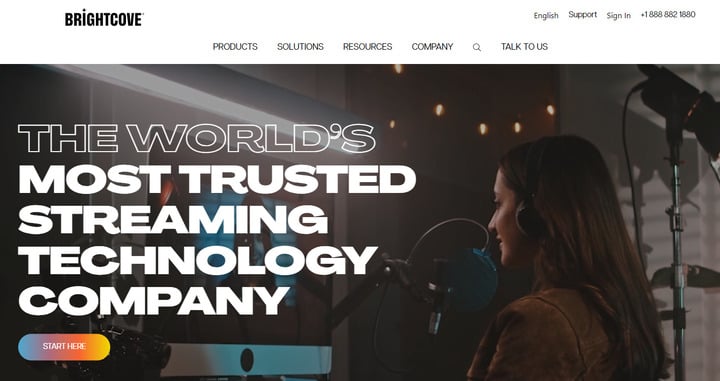
If you are looking for a more corporate video hosting platform, Brightcove is one to consider. Used by Fortune 500 companies, Brightcove integrates with other marketing tools to support branding, mobile optimization, lead generation, and advertising.
Since it is an enterprise platform, you must contact their support team to get a quote for their products. Brightcove is a complex platform, so you will need a deep understanding of marketing and advertising to make the most of this video hosting site.
9. SproutVideo

Ideal for small businesses and solopreneurs, SproutVideo is an excellent pick for creating customizable video players for websites and mobile devices. Its analytics features allow you to track engagement in real time, showing data such as geographic location, engagement rate, and where your videos are being seen. SproutVideo integrates with major third-party platforms like Hubspot, Mailchimp, and Zapier.
SproutVideo also has livestreaming functionality that is equipped with real-time data analytics. They offer a range of pricing plans, depending on your video hosting needs, from $10/month to $295/month. A free trial is available as well, making SproutVideo a risk-free option to consider.
10. Uscreen

For those who are looking for a video hosting platform for gated communities, Uscreen is an excellent pick. What separates Uscreen from other WordPress plugins and learning management systems is that it is a VOD library you can use to share exclusive content.
Uscreen is best for larger businesses looking to create Netflix-style content where audiences can sift through a collection of videos at their discretion. Higher-tier plans also allow you to create your own mobile app so you can customize your user experience even further.
The Growth plan starts at $199/month (paid annually) and offers up to 100 hours of stored video, a custom domain, and payment processing integrations. The Pro plan starts at $499/month and has everything in the Growth plan plus a customizable mobile app, 150 hours of video storage, live streaming for up to 10 hours, and third-party integrations.
11. Cincopa

With video hosting, live streaming, image hosting, and more, Cincopa is a great option for small—to medium-sized businesses. Their analytics can show you the exact demographics of each individual viewer, giving you critical information to grow your viewership.
Cincopa can be used in a wide variety of ways, such as eLearning, personalized video messages, eCommerce, Netflix-style video channels, and corporate training. Additionally, you can use Cincopa’s free Chrome extension, RecTrace, to screen record. Videos are stored permanently and can be embedded in websites. Cincopa pricing plans start at $25/month and have an enterprise-level tier at $350/month.
12. Muvi
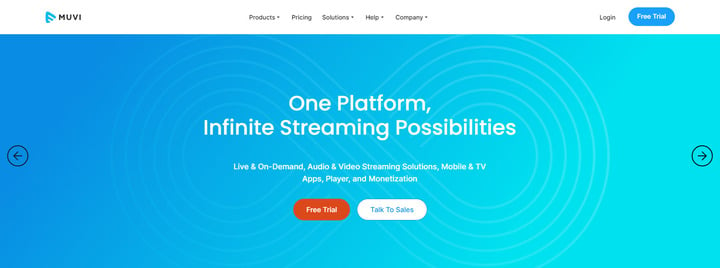
Trusted by major companies like Intel, Phillips, Sony, and Amazon Prime Studios, Muvi is a video hosting service that works best for hosting streaming channels for your audience. Similar to Brightcove and Uscreen, Muvi shines as a VOD platform where you can share exclusive content through a paid subscription. Muvi also has pay-per-view options and an option to set up your own film festival!
Muvi is an enterprise-level platform, so you will need a higher budget to make the most of this platform. Starting at $339/month (paid annually), you get access to a white-label website and mobile app that allows you to present your video content in alignment with your brand.
13. Hubspot
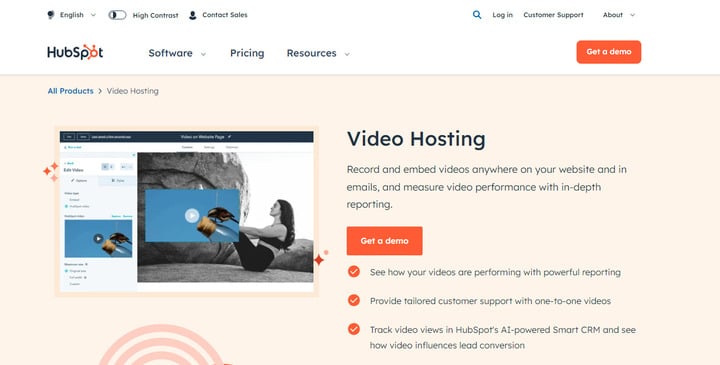
Last but not least is Hubspot. If you already use Hubspot tools for email marketing or as a CRM, adding video hosting can also help keep your tools centralized. It will integrate seamlessly with all Hubspot tools, reducing any technical headaches.
Hubspot video hosting works best in your marketing and sales departments, making it an excellent consideration for enterprise-level businesses. The downside is that Hubspot video hosting does not offer the same VOD or streaming capabilities as other platforms like Brightcove, Muvi, and Uscreen.
Prices range from $400/month to $4000/month, depending on the video hosting package you choose.
Find the Best Video Hosting Platform for Your Business Today
Although content marketing trends continue to evolve, video content will keep playing a prominent role. That is why it’s so important to get ahead of the game and identify the best place to host your video.
Whether you are looking to grow your membership, increase sales, deliver personalized videos, or live stream, your business has many options available, regardless of size.
Take advantage of the free trials to find the best video hosting platform for your audience’s needs. Video hosting is critical in your video content strategy, so start today and identify the best place to house your content.